I’ve talked before about how “right sizing” my patch of grass really changed my perspective on “evil, non productive lawn” to something almost like fondness.
Well, my thinking on lawn has shifted yet again, and again for the better. We recently converted to an eco-lawn mixture and these days I find myself downright loving my lawn.
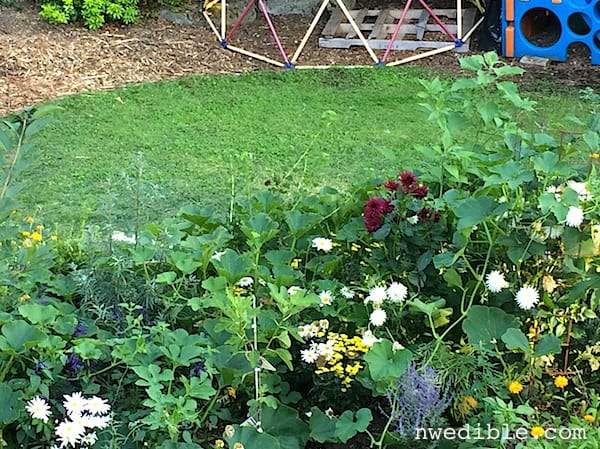
Don’t let the fancy name and Prius-marketing fool you: an eco-lawn is simply a collection of plants that work together to give you a consistently lush, foot-friendly patch of green with less water, less work, and little or no fertilizers. Some blends include low growing herbs and teeny flowers, but these aren’t essential – they just add some prettiness to the mix. The key ingredients in most eco-lawn blends are a blend of drought-tolerant fescue grasses and low growing clover.

Fescues are pretty common in cool-climate grass seed blends, so I’ll assume most folks are reasonably familiar with this component of an eco-lawn.
Here’s why the addition of clover is important. Clover is a member of the legume family, and – with the help of some beneficial microbes – has the quite awesome ability to take nitrogen out of the freaking air and turn it into fertilizer. The legume plants are kinda like the people in Cloudy with a Chance of Meatballs before everything went wrong – they can just snatch their snacks out of thin air.
The nitrogen that the clover doesn’t need immediately away gets stored away in cool little bead-like nodules on its roots, much like my thighs expand with convenient storage fat when I recipe test too many plum galette recipes (OMG, so good).
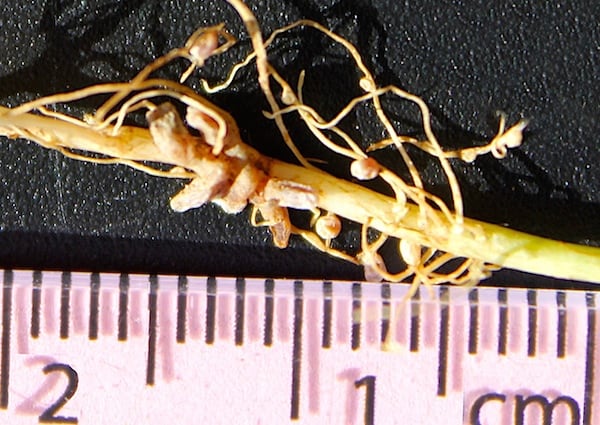
Rule number one about understanding plants is this: the leaf mass and the root mass are always kept in balance. You cut the top, some roots die. You screw up transplanting and kill off a bunch of roots, some leaf mass dies off until the plant can get the root mass rebuilt. Internalize this and everything from lawn care to tree pruning will suddenly make so much more sense. So when the clover loses leaf mass – because a sheep nibbles it or you come through with your push mower to cut your lawn – the roots of the clover die off to compensate.
This leaf-root balance is key to a successful eco-lawn. When the clover roots – all full of those nitrogen nodules – die off, the nitrogen is released into the soil like some nature-made Miracle Grow, available for neighboring plant roots to scoop up and use. And you know who just loves lots of nitrogen? Grass. Grass loves nitrogen so much that chemical lawn fertilizers have redonkulous NPK ratios like 26-0-2 or 32-0-4.
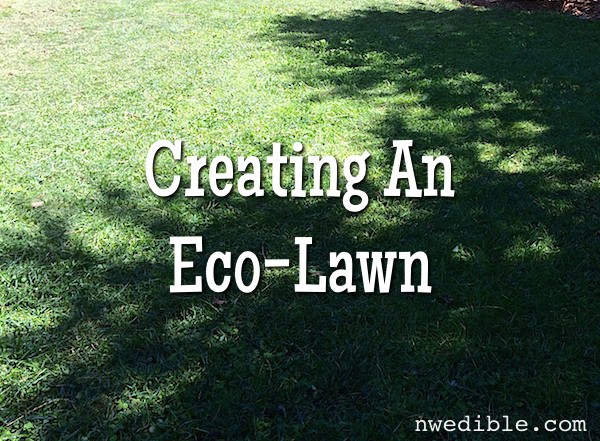
When you blend grass with clover you are setting up a lawn system that does not require additional fertilizer. Every time you mow, the clover feeds the grass through those cast off nitrogen nodules. And, just in case I didn’t fully emphasize this enough, this is all fed by nitrogen that is in the air. So this process is totally free and requires no additional work on your part.
I researched several brands of eco lawns and the major drawback to every one of them is that they are expensive, at around $30 a pound. Since most eco lawns are simply a blend of fescue grasses and clover plus whatever pretty stuff seems like a good idea, I thought I could save money by blending my own eco lawn seed mix.
I was wrong.
Fescue blends are cheap – you can get 5 pounds for about $15 – but most eco-lawn mixes include a very small leaved variety of clover called microclover or miniclover. This clover is very expensive – about $40 a pound. So, if you are DIY’ing a small eco-lawn, it can actually make more sense to just buy the pre-made blends.
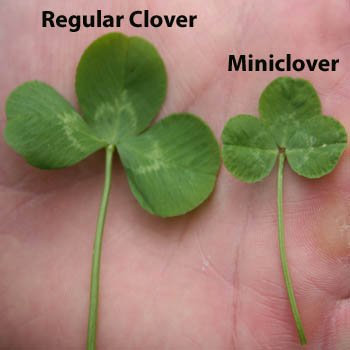
But there is another option. White clover, while not nearly so cute and diminutive as microclover, makes a perfectly serviceable lawn component and is cheap – you can find it for like $5 a pound. Other clovers – particularly crimson clover, an annual, and the red clovers, which are more upright and less dense in their growth – aren’t as good for a lawn.
Whatever clover matches your budget and personal aesthetic, adding clover to the mix of ground covers that make up your lawn is a very good idea. I went with a no-name eco-lawn blend from my local nursery, supplanted with some additional white clover.
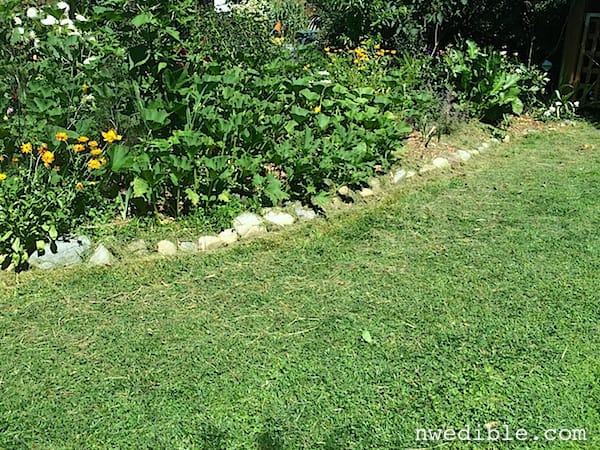
Establishing an eco-lawn takes the same care as establishing an all-grass turfgrass lawn. If you are overseeding a current lawn, raking away thatch to expose bare earth is important. If you have bare earth, good soil prep including grading and amending your soil is key.
I was dealing with neglected grass that had been partially killed off by (unintentional) smothering. I raked the grass area well to remove thatch, then re-graded the lawn area with peat moss. Using a crappy, hand-held seed spreader, I distributed the eco-lawn blend. After about a week of keeping the seeds watered, they germinated. After about a month, the new lawn was really filling in. Now, while it’s not yet as dense as it will be, it’s full and green with very little care. Since the eco-lawn established, about 6 weeks after sowing, we’ve barely watered and yet the lawn has stayed very green. We mow about every 3 – 4 weeks in the summer, which is probably half as often as we mowed our full turfgrass lawn.
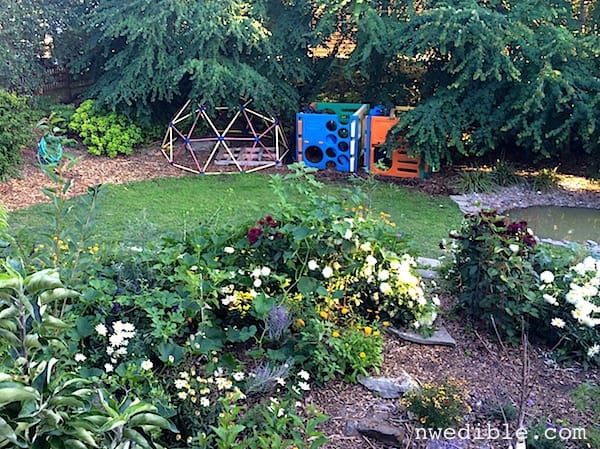
One possible disadvantage is that clover in blossom is very attractive to honeybees. I think this is awesome, but if you have an allergy to bee stings, you’ll need to mow frequently enough to keep the clover from blooming.
75
I really liked learning about this system. I am going to locate some eco lawn seed and try it myself. Once established, do you have to water an eco lawn in the middle of summer? If you let it go brown, will it come back? Or is that not a problem in your neck of the woods?
What an interesting article. Now I’m wondering if any of these ideas can be used to naturally fertilize the garden. Any ideas?
I started planting white clover into a very sparse “lawn” several years ago. Sometimes I mixed it with a Sun/Shade grass mix and sometimes I planted it by itself. I have been very happy with the results. After struggling to have something green underfoot I finally have a nice patch with some Ajuga. violets, and of course, still some crab grass (but less of that) . I like the clover blooms since my neighbor has beehives and her bees can forage in my yard. My chickens also like to pull the blossoms off and eat them.
Hey that’s what I have – a clover lawn! I know it’s not as perfectly golf-course like as some of the suburban yards I see, but I personally like my clover lawn that doesn’t need me bending over backwards to take care of it – it takes care of itself 🙂
An excellent primer on legumes and nitrogen fixing. Your lawn looks great! Could you please post a picture of how it looks in the winter?
Just to clear up a common misconception … true honey bees (not wasps/yellow jackets, which most people mistake for honey bees) will only sting to defend their hive. Yes, I suppose you could step on one, but they generally just fly away to the next flower.
We actually have clover in our front and back yard (intentionally), and we’ve never had a problem with being stung walking through the lawn.
True! But having a ton of clover in your lawn does make it more likely that bees will be underfoot and you will step on them if you walk around barefoot. In fact, that’s exactly how my barefoot son was stung last summer. The solution is pretty easy, though: either mow more, or wear shoes. 😉
Thanks; this makes me feel way better about the yard. I added white clover to help fill it in and add nitrogen. But I didn’t use any inoculant to boost the nitrogen-fixing. Is that a necessary step?
The bees love it, and the only time I got stung was when I was rolling down the hill with my son and squashed a bee. It’s hard to keep the flowers mown, though; we mow high to protect the fescue roots and so plenty of blooms are missed.
Can you help with a natural way to rid the “lawn” of black medic? We live in a fairly dry area and I don’t water much of the huge yard to conserve our drinking water and save it for garden and trees. But, yuk. Total black medic seed farm! I’d much prefer clover.
Somehow I managed to make an eco-lawn without even trying, because the soil we used was full of clover seeds, which actually started sprouting before I even seeded the grass. Now I have lots of clover mixed with grass. WooHoo!
I keep trying to boost my lawns’ fescue and clover ratio, but the “dandelawn” refuses to drop the dandelion component. Bi-weekly beheading of their budding flowerstalks and brute force extirpations with a Fiskars yanker-outer has prevented the need to go scorched-earth with herbicide and heavy artillery. I will overseed with white clover, though that has to await the return of the rainy season. I like your catchy label of “eco-lawn”.
Unfortunately I live in Texas, near DFW. Fescue would not survive here. Most plant bermuda until trees create shade, then use St Augustine sod. I have removed all grass in front yard but have a small lozenge of mostly smothered out St Augustine in back. I use white clover (not mini) as cover crop in veg patch. Now I am inspired to use the clover to intermingle with the grass in back.
Question: what about water demands of clover in an area with a long, hot, drought prone summer then spells of ice in winter? Rather than properly preparing the soil might I just use the foot-powered aerator,then overseed with clover? Of course I’d rake up all the live oak leaves that smothered the St Augustine first. Will appreciate any suggestions from Erica or other readers.
I would love to know this too- I live in the greater Los Angeles area and obviously have the same dry, drought- prone issues (thankfully not the ice though). I’m hoping someone might have ideas for an eco-lawn for this type of environment, since we’re buying a house soon!
As always, you inspire me! I’ve been letting some large clover take over my lawn because I think it looks better than my scraggly crummy grass but I like the idea of making it more purposeful with white clover. Maybe then the lawn will make me less aggravated. I’d be happy to smother it all out and cover it with wood chips or something but my husband is not buying in to my vision. This may be the compromise we need! 🙂
This article explains why my lawn looks so good! I’ve never tried to make my lawn more like a “LAWN” by weed killing and grass seeding it. I’ve just always enjoyed the variety of flowers that grow and the clover and gilly weed make up about 60% of the lawn, so the local bees are pretty happy too. My front lawn is the only colorful one on the block and its always green and lush even though I never water. I also have found the more natural flora of the lawn allows me to get away with only mowing about once every two weeks. Nice perk.
Hi Erica, I love your ecolawn. I recently bought a home on a .27 ac lot outside of Portland, OR and my lawn is mostly white clover and whatever lawn was here. I am wondering if the part of my lawn that has dried to brown without water will return when the rainy season comes? We water a portion of the lawn for the grandkids and dogs, but have allowed some areas go dry. I know before long we will have plenty of rain…
Most lawns in Portland turn brown in the summer without irrigation. Yours should green up in the fall! It is possible it is not alive, but I would definitely wait until it has a chance to recover in the fall before tearing it up.
Thanks Melissa! I have just returned to the rainy PNW from the cool and lovely SFO Bay area. So different. I will keep my fingers crossed, we are not looking for a golf course lawn, just play area. Hoping to convert some of our space to Urban Homestead as time allows. Thanks for the great information on this BLOG!
I’ve read about clover lawns before, but the main selling point in the article was just that they’re short and don’t require mowing. Super intrigued to hear that they also introduce nitrogen into the soil! I’m definitely keeping this idea on my back pocket for that elusive day when we finally buy a house.
Oh, the best reason to grow clover is the nitrogen fixing! It’s just awesome for it!
Any idea how tasty this lawn would be to deer? We have a very small patch of grass that we’ve contemplated turning into a bee-attracting flower bed. It sounds like clover would be so much easier while still supporting bees. But we have a lot of deer in our yard and I wonder if they would just eat it to death.
I can’t speak from direct experience, but clover is highly palatable as a forage to most animals who eat grass/pasture.
Yes! We moved into our sod-surrounded PNW house six years ago. After years of easily worn grass that bakes and goes dormant in warm weather, we purchased a Sun & Shade seed mix from Gardensphere in Tacoma. We are over-seeding the part of our yard we keep as a lawn the mix and white clover. So far, the new growth is lush underfoot and green in spite of the heat. Love it!
Hmm, is it an eco-lawn if there are blackberries and thistles popping up all over the place? We’re still working on our oversized (for Portland) lawn that was pretty recently a blackberry bramble. The clover is definitely my favorite thing. There is a patch of it between our driveway and our neighbors that is 95% clover, and we’re not mowing it. It’s white clover and it’s stabilized at 4-6″ tall. Our puppy loves to lie in it, and the bees are all over it.
So what about snows? Especially, after the snow melts. I am assuming it grows after the snow melts, but I don’t want lots of mud!
Thanks! Great article.
Two questions Erica. What variety of seed did you use for this lawn? And two, have you ever had a Bindweed and how do you deal with it? I have TONS!!!
Would eco-lawn grow in the south? I live in Mt. Pleasant, SC which is located next to Charleston. The soil is sandy. The climate is very hot and humid in the summer and cool in the winter. My son in Portland , Oregon is planting an eco-lawn in his back yard and is super excited about the benefits of your product.
Hi mates, its enormous post concerning tutoringand fully explained, keep it
up all the time.
This is my first time pay a visit at here and i am truly pleassant to read all at one place.|